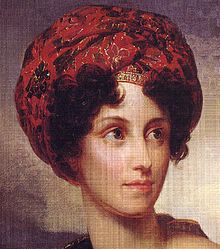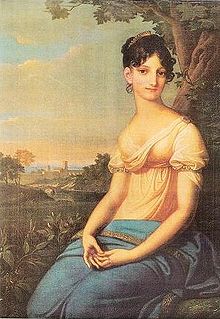- Princess Dorothea of Courland
-
Princess Dorothea of Courland Duchess of Dino, Duchess of Talleyrand, Duchess of Sagan 
Spouse Edmond de Talleyrand-Périgord (m.1809-1818) Issue Napoléon Louis de Talleyrand-Périgord
Dorothée de Talleyrand-Périgord
Alexandre Edmond de Talleyrand-Périgord
Pauline de Talleyrand-PérigordFather Alexander Batowski Mother Dorothea von Medem Born 21 August 1793 Died 19 September 1862 (aged 69) Religion Lutheranism then Roman Catholicism Dorothea von Biron, Princess of Courland, self-styled Dorothée de Courlande (21 August 1793 – 19 September 1862), was a Baltic German noblewoman. Her mother was Dorothea von Medem, Duchess of Courland, and although her mother's husband, Duke Peter von Biron, acknowledged her as his own, her true father was a Polish statesman Aleksander Batowski, thus making her half-Polish. She was a lover of the French statesman Talleyrand and the wife of his nephew, Edmond de Talleyrand-Périgord.
Contents
Life
Dorothea was born in Friedrichsfelde near Berlin, the fourth and last daughter of Duchess Dorothea of Courland, who was by then separated from her husband. Dorothea's paternity is disputed but generally assigned to Aleksander Batowski, a Polish envoy to the Duchy of Courland, her biological father was a close associate of her lover Talleyrand during the Napoleonic period. Her three elder half sisters, all legitimate daughters of the Duke, were: Princess Wilhelmine, Duchess of Sagan; Princess Pauline, Duchess of Sagan; and Princess Johanna Katharina, Duchess of Acerenza. She was educated in Germany.
Marriage
Looking for a wealthy heiress for his nephew Edmond, Talleyrand asked Tsar Alexander I of Russia to intervene with Dorothea's mother in favor of Edmond's marrying her. The marriage occurred on 21 and 22 April 1809 at Frankfurt amidst the Napoleonic Wars, presided over by Talleyrand's friend, Prince-Bishop Emmerich Joseph, duc de Dalberg, and Dorothea thus became comtesse Edmond de Périgord and great-niece of Charles-Maurice de Talleyrand-Périgord, prince of Bénévent. Educated in Germany, she was plunged into French society, where she represented the enemy. Her three sisters, also very anti-French, did not help her marriage and despite the birth of three children, it became unhappy, with Edmond more concerned with gaming, war and other women than with his wife.
The fall of the First French Empire and the Congress of Vienna (at which Talleyrand was designated to represent France) favoured an affair between Dorothea and Talleyrand. During his time in Vienna she kept her household in the Palais Kaunitz and it was at this time that Dorothea began to play a major part in Charles-Maurice's life, accompanying him to the Congress of Vienna and probably becoming his mistress sometime after 1815. On 31 August 1817, Talleyrand was made a duke and peer of France by Louis XVIII of France, and on 2 December was also granted the duchy of Dino (a 1.5 km by 1.2 km Calabrian island) by the king of Sicily in recognition of his services at Vienna. The duchy of Dino was immediately handed down to his nephew and his wife and so Dorothea also became duchess of Dino. On 24 March 1818 she and her husband separated, though this was only pronounced formally on 6 November 1824.
Her life with Talleyrand
On 3 July 1820 Talleyrand left Paris for Valençay accompanied by Dorothea, then pregnant with her third child, Pauline, whose paternity is sometimes attributed to Talleyrand. Despite his company (39 years her senior) she took several lovers, gaining a reputation as a formidable seductress and bearing three illegitimate daughters (one of whom, born in 1816, was perhaps Bozena Nemcova, the great Czech writer, fathered by Clam Martinic, her lover at the Congress of Vienna; the two others, Antonine and Julie Zulmé, were born in 1825 and 1827).
She became duchess of Talleyrand on 28 April 1838. On 6 (or 8) January 1845, the king of Prussia invested Dorothea as duchess of Sagan (with the special privilege of the dukedom being able to descend via the female as well as the male line), with her son Louis-Napoléon, godson of Napoleon and Louis-Napoléon's grandson Boson de Talleyrand-Périgord immediately taking the title of prince of Sagan.
When Talleyrand became French ambassador in London in 1830, she accompanied him and felt more comfortable there than in Paris, which she detested and where the whole Faubourg Saint-Germain made her feel she was a foreigner. This was a theme throughout her life: in Prussia she was seen as too French, in Paris as too German.
After Talleyrand's death in 1838, she granted her château de Rochecotte to her daughter Pauline de Castellane in 1847, having chosen in 1843 to live in state at her castle at Sagan in Silesia (made up of 130 buildings on an estate of 1,200 hectares, bought by her father and then by her sister Pauline de Hohenzollern). She reigned over this immense and rich duchy alone, until she had a carriage accident in June 1861 and died on 19 September 1862 at Sagan.
Despite the wish she had expressed to her uncle and probable lover Talleyrand in a letter of April 1838 and in her will, that her heart should be placed in his grave at Valencay, she was buried in the Kreuzkirche at Sagan, with her sister Wilhelmine and son Louis.
Issue
With Edmond de Talleyrand-Périgord
- Napoléon Louis de Talleyrand-Périgord, 3rd Duke of Talleyrand[1]
- March 12, 1811 – March 21, 1898
- married Anne Louise Charlotte de Montmorency on February 26, 1829 at Paris
- Dorothée de Talleyrand-Périgord
- 1812–1814
- Alexandre Edmond de Talleyrand-Périgord, 3rd Duke of Dino
- December 15, 1813, Paris – April 9, 1894, Florence
- married Valentine de Sainte-Aldegonde on October 8, 1839 at Beauregard
Disputed paternity
- Pauline de Talleyrand-Périgord
- December 29, 1820 – 1890
- attributed to Charles Maurice de Talleyrand-Périgord
Unknown paternity
- Antonine
- born 1825
- Julie Zulmé
- born 1827
Speculated to be hers
- Božena Němcová
- may have been fathered by Karel Clam-Martinic (1792–1840), Dorothea's lover at the Congress of Vienna.
Reception
The young writer Françoise Quoirez (1935–2004), in reading a passage of Marcel Proust evoking a duke of Sagan around 1950, was seduced by its sonority and chose "Sagan" as her "nom de plume".
“(..) With large dark blue eyes, very beautiful, so burning that they appeared black to some people. There was in her something bold, wild, dauntless and burning one which held the gaze". (Casimir Ensconce, "Talleyrand amoureux", edition France-Empire, 1975).
The opinions she inspired are various; those of men, admiring her beauty and intelligence, praise her, but those of women, jealous of her position and wealth, are more venomous. It is strange that she had no close female friends but instead was a solitary figure, despite keeping up a wide correspondence with many personalities of her era. She was a true European, in an era where that word was unknown. Born between two cultures, speaking three languages, in contact with all the political personalities of Europe, she could have been, in another era, thanks to her intelligence, a scholar or politician. But in that era, only men had a career, and so she was unable to realize her numerous talents. As Guizot said of her: "une personne rare et grande".
The duchess of Dino also has a descendant in Touraine, a "calm and human region, of a pure, very poetic beauty", in the person of Béatrice of Andia, one of her great-great-great granddaughters, president of the association of the "Friends of château d'Azay-le-Rideau", owner of château de La Chatonnière.
Styles
- 1809: Comtesse Edmond de Périgord
- 1817: Duchesse de Dino
- 1838: Duchesse de Talleyrand
- 1845: Duchesse de Sagan, now Żagań, Poland
Her properties
- Château de Bouges (Indre), bought for her in 1818 by Charles-Maurice de Talleyrand-Périgord
- Château de Rochecotte (Indre-et-Loire), overlooking the Loire valley, bought by her 30 April 1828, rebuilt by her. She wrote of it "He took me away from these deep and melancholy regrets to this soft and tranquil Rochecotte" ("Il me prend des profonds et mélancoliques regrets pour ce doux et tranquille Rochecotte..." - letter of 1862)
- Château de Sagan (Lower Silesia, now Żagań in Poland), bought in 1843 by her elder sister, Pauline, princess of Hohenzollern-Hechingen
- Château de Günthersdorf (Lower Silesia, today Zatonie in Poland), bought in 1840
Her memoirs
- Dorothée, princesse de Courlande, duchesse de Dino, Mémoires . Tome I, 1794-1808 : souvenirs d'enfance de la princesse de Courlande (texte établi par Clémence Muller). – Clermont-Ferrand : Paleo, coll. « Sources de l'histoire de France », 2003. – 173 p., 21 cm. – ISBN 2-84909-022-0.
Chronologically:
-
- Mémoires. Tome II, 1831-1834 (texte établi par Clémence Muller). – Clermont-Ferrand : Paleo, coll. « Sources de l'histoire de France », 2003. – 258 p., 21 cm. – ISBN 2-84909-039-5.
- Mémoires . Tome III, 1835-1837 (texte établi par Clémence Muller). – Clermont-Ferrand : Paleo, coll. « Sources de l'histoire de France », 2004. – 228 p., 21 cm. – ISBN 2-84909-065-4.
- Mémoires . Tome IV, 1838-1840 (texte établi par Clémence Muller). – Clermont-Ferrand : Paleo, coll. « Sources de l'histoire de France », 2004. – 243 p., 21 cm. – ISBN 2-84909-071-9.
- Mémoires . Tome V, 1840-1843 (texte établi par Clémence Muller). – Clermont-Ferrand : Paleo, coll. « Sources de l'histoire de France », 2004. – 244 p., 21 cm. – ISBN 2-84909-092-1.
- Mémoires . Tome VI, 1844-1853 (texte établi par Clémence Muller). – Clermont-Ferrand : Paleo, coll. « Sources de l'histoire de France », 2004. – 220 p., 21 cm. – ISBN 2-84909-109-X.
- Mémoires . Tome VII, 1854-1862 (texte établi par Clémence Muller). – Clermont-Ferrand : Paleo, coll. « Sources de l'histoire de France », 2004. – 203 p., 21 cm. – ISBN 2-84909-112-X.
See also
References
Preceded by
Princess Pauline of CourlandDuchess of Sagan
29 November 1838 – 19 September 1862Succeeded by
Napoléon Louis de Talleyrand-PérigordExternal links
Categories:- 1793 births
- 1862 deaths
- Baltic nobility
- Baltic-German people
- French duchesses
- House of Biron
- Napoléon Louis de Talleyrand-Périgord, 3rd Duke of Talleyrand[1]
Wikimedia Foundation. 2010.


